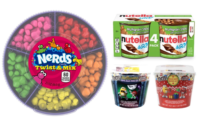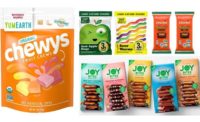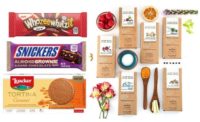2021 State of the Industry Category Break downs:
Throughout July 2021, Candy Industry will be taking a deep dive into various confectionery categories. As stories are posted, they will be linked here.
- Jellies, fruit chews, licorice bolstered by growth of non-chocolate chewy category
- Hard candy sales shrink through COVID-19 pandemic
- Better-for-you, reduced-sugar treats gain momentum
- Chocolate bar sales are up overall compared to pre-pandemic levels
- Novelty sector navigates licensing, changing consumer trends amid COVID-19
- Gum sales tumble through COVID-19, but rebound expected
- Accessible, pandemic-related gifting lifts truffles, pralines and filled chocolates category
It’s been over a decade now since I started working for Candy Industry in December 2010, and in all that time I have never witnessed the kind of massive changes that have happened within the confectionery sector over the last year.
Yes, self-checkout, ecommerce, sustainability, cannabis, and Millennials have all created foundational changes in the confectionery industry over the last 10 years. But before the pandemic, the industry seemed to have time to get its footing as each new change hit.
COVID-19 took all of those issues, accelerated them, and then added new ones to the mix. Now there are also major supply chain problems, heightened health consciousness among consumers, struggling gum and mint sales, a lack of in-person events for more than a year, and more.
In December 2020, we detailed how the pandemic had played out in the candy industry to that point. While it’s not even a full year later, it seems like the entire world has already changed again since then — a feeling that no doubt comes from trying to keep up with rapid changes.
So how is the industry doing?
To get a clearer picture of how categories are doing compared to pre-pandemic sales, we tracked down 2019 IRI data we still had on file.
Below, we compared data from now, which is IRI data from the latest 52 weeks, ending May 16, 2021, to 2019, which showed the latest 52 weeks ending Sept. 8, 2019.
Both chocolate and non-chocolate are doing very well.
Chocolate:
Now: Up 5.7 percent to $15.6 billion
Sept. 2019: Up 2.3 percent to $14.4 billion.
Non-chocolate:
Now: Up 6.9 percent, $8.3 billion
Sept. 2019: Up 3.1 percent to $7.6 billion.
Unfortunately, gum, breath fresheners, and mints are still struggling, especially when comparing the current numbers to 2019 data.
Gum sales:
Now: Down 19.8 percent to $2.4 billion,
Sept. 2019: Up 2.2 percent to $3.1 billion
Breath fresheners sales:
Now: Down 22.9 percent to $553.8 million.
Sept. 2019: Up 0.6 percent to $783 million.
Mint sales: (Categorized as part of non-chocolate on the IRI data)
Now: Down 11.7 percent to $325.3 million.
Sept. 2019: Up 2 percent to $386.2 million.
Seeing the numbers next to each other makes it clear that the gum, mints and breath fresheners sectors have a long way to go to get back to pre-pandemic levels.
Managing Editor Alyse Thompson and I recently attended the NCA’s Sweets and Snacks Expo in Indianapolis. As the industry’s first major U.S. show to be held in-person since March 2020, it was the perfect place to get a sense for the current state of the confectionery industry.
From my perspective as a reporter, the Expo has traditionally been focused on launching new products. Yes, some other issues impacting the overall industry were usually crystallized as part of the process, i.e. companies launching reduced-sugar chocolate pointed to overall trends in consumers’ attitudes toward sugar.
And while there were plenty of new products to see at this year’s Expo (see product round-ups here and here), the overall tone of the conversation focused on a lot more than the latest sweets to hit the market. Everyone was focused on all the massive changes that have happened since we’d last seen each other.
Indeed, even the statistics about the Expo itself offer a glimpse into how the confectionery industry is doing.
According to the NCA, the 2021 Expo had:
- Thousands of attendees
- 450+ exhibitors
- 2,890+ retail attendees
- 1,750+ banners across all classes of trade
- More than 3 acres of candy and snack innovation
- $6.3 million economic impact on the City of Indianapolis
While we couldn’t find those exact statistics for the 2019 event, the most recent in-person event, at the time the NCA said it drew more than 15,000 total visitors, and “more than 800 companies displaying more than 4 acres of candy and snack products participated in the Expo.”
The stats reveal that while the 2021 Expo was maybe the clearest sign yet that the industry is pushing forward, the effects of the pandemic linger.
During a meeting on the show floor, Mars Wrigley’s Mike Gilroy, v.p. of trade development, detailed some of the ways the pandemic had impacted the company.
“Consumers, their path to purchase is evolving, and it’s evolved pretty quickly, right?” Gilroy said. “Through COVID, fewer trips, larger baskets, less contact and then certainly a massive shift to digital. What happened in five months should have happened in the next five years.”
Online grocery shopping dramatically impacts one of the ways candy has traditionally been sold — at the checkout.
“Confectionery is all about impulse, right? Build those displays. Make consumers make a conscious decision not to buy it. But when they’re not coming into the store, how do you capture that impulse moment? So that’s a real challenge... and we’re working through that,” Gilroy said. “Depending on whether you're the pessimist or the optimist, there’s a $2 billion solve that needs to be done here. If impulse goes away, that’s a problem for the confectionery and snack and soda business. But how do we resolve that? I can tell you from conversation internally that there’s a lot of creative time being spent discussing what are potential solutions to these issues.”
He mentioned the possibilities of working with apps to suggest impulse purchases to shoppers at various points in the process, and he also offered some possibilities for how stores themselves might evolve.
“What can the retailers do as they rethink their four walls, what’s the thinking, what does the store of the future look like?” Gilroy said. “It’s not going to be if you have 50,000 sq. ft. that there’s 10,000 sq. ft. dedicated to storage and 40,000 dedicated to merchandise. It might be [25,000/25,000] because now you’ve got all your picking for your curbside pickup.”
Meanwhile, on the other end of the supply chain, logistical issues are creating problems for candymakers.
During a meeting with Ferrero at the Expo, Paul Chibe, president and CEO of Ferrero North America, talked about what it’s been like to try to navigate them.
“Consumer demand is growing in the United States, it’s growing in Asia, and it’s just putting a lot of pressure on supply chains because they went from one scenario where things are kind of quiet and in trouble,” he said. “And now the consumers who have been at home have accumulated savings and now they’re spending, and that’s putting a lot of pressure on global supply chains.”
Chibe also cautioned the industry against under-reacting to the problems.
“We’re doing all we can to try to mitigate it,” he said. “It can slow down the recovery of the economy if these issues remain.”
Only time will tell whether it does. For now, the future of the candy industry looks pretty bright. According to a May 2021 report from Fior Markets, the global candy market is expected to grow from $217.8 billion in 2020 and reach $290.7 billion by 2028, growing at a CAGR of 3.8 percent during the forecast period 2021-2028.
The question is, what will the path to those 2028 sales numbers include?
Throughout the month of July, Thompson and I will break down the state of each candy category, offering even more in-depth analysis and information about how they are faring at the moment, and what problems they might face as the world continues to be impacted by a global pandemic that isn’t quite in the rearview mirror yet.
So make sure to check back for more comprehensive guides to the sectors. They’ll be posted on our homepage, shared on social media, and added to a list on this article as they are posted.





